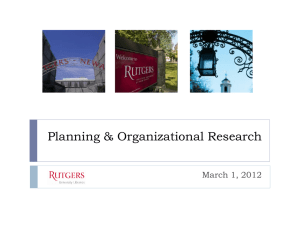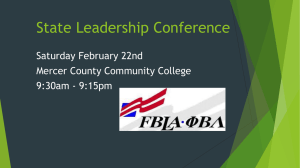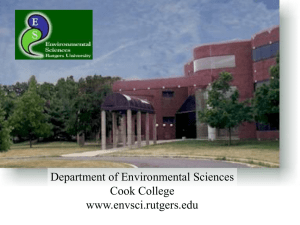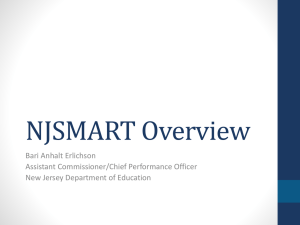Strategic Planning Process - Robert Wood Johnson Medical School
advertisement
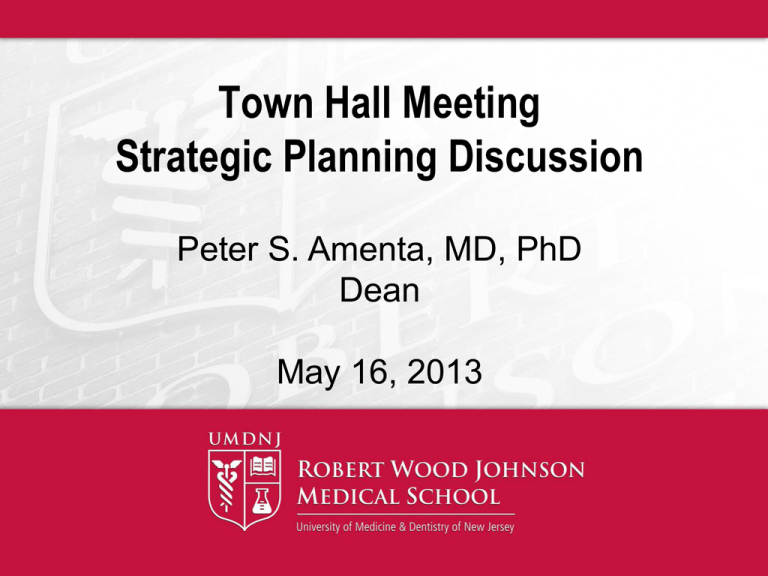
Town Hall Meeting Strategic Planning Discussion Peter S. Amenta, MD, PhD Dean May 16, 2013 Outline • UMDNJ Today • Rutgers Tomorrow • Our Strategic Plan 2009 - 2012 2013 – Forward • • • • • • Strategic planning charge Strategic planning process Vision and Mission Statements Missions and Signature Programs Final Draft of the Strategic Plan The Virtuous Cycle & Our Strategic Plan Brief Introduction to the RU Strategic Plan What You Can Do Next UMDNJ Today • UMDNJ is New Jersey's university of the health sciences and the nation's largest public university of the health sciences. • It is comprised of 8 Schools: Robert Wood Johnson Medical School New Jersey Medical School School of Osteopathic Medicine New Jersey Dental School Graduate School Nursing School School of Health Related Professions School of Public Health • Two hospitals: University Hospital (Newark) and University Behavioral Health Care Integration: Rutgers Health Sciences Rutgers Biomedical and Health Sciences (RBHS) will serve as the umbrella organization for units from both universities. From UMDNJ Graduate School of Biomedical Sciences New Jersey Dental School (Renamed Rutgers School of Dental Medicine effective July 1, 2013) New Jersey Medical School Robert Wood Johnson Medical School School of Health Related Professions School of Nursing School of Public Health University Behavioral Health Care Cancer Institute of New Jersey, a nationally designated Comprehensive Cancer Center reporting directly to Rutgers’ president Integration: Rutgers Health Sciences From Rutgers Ernest Mario School of Pharmacy College of Nursing Institute for Health, Health Care Policy, and Aging Research Other units at the discretion of Rutgers’ president Joint Centers and Institutes Center for Advanced Biotechnology and Medicine Environmental and Occupational Health Sciences Institute Benefits of Integration • Strengthen partnerships between higher education and health care industry in New Jersey • Enhance educational opportunities • Strengthen recruitment of top faculty and students • Attract increased federal research funds • Foster highly productive and innovative multidisciplinary projects • Catalyze new VENTURE companies & create jobs Benefits of Integration • Big 10 Academic Medicine & Committee on Institutional Cooperation (CIC) • Among top 25 according to the National Science Foundation (NSF) for Total Federal Research and Development Expenditures • Enhanced collaboration, e.g. participation in clinical trials and novel therapies among Rutgers, Robert Wood Johnson Medical School and Cancer Institute of New Jersey Our Strategic Plan • Charge and Process of planning • Addressing our challenges • Iterations with internal and external stakeholders • Where we are today Strategic Planning Charge • Create a Shared Vision of what we can do best, how we differentiate ourselves, how we set priorities and make go/no-go decisions, how we recruit, retain, and foster the work of the best people • Context of Missions • Consider Signature Programs • Review and Build on past accomplishments Strategies for Addressing Challenges – Siloed/Not Comprehensive Strategic Planning to Facilitate Future Differentiation Research Opportunities and Discovery Revenue Cycle Enhancement/ EMR Enhancing Alignment with Principal Teaching Hospital Renegotiation of Managed Care Contracts Challenges 2006 Enhanced RWJMG Function Philanthropy Enhancing Organizational Efficiencies Addition of New Services and Programs Expansion of RWJMG beyond New Brunswick Patient Care & Community Health • Recruited excellent faculty physicians Trauma, Transplant, Neurosurgery, Maternalfetal medicine, Cardiovascular surgery, to be continued • Reorganized Faculty Practice Plan to improve patient care and access Created an integrated practice from a federated departmental model, reorganized staffing and phone coverage, and funds flow • Established Electronic Medical Record Received meaningful use funds, EBCHC now online, with 1800 patients on patient portal • Enhanced financial status Negotiated vastly improved managed care rates, refined productivity data, W&C, MPA • Expanded outpatient practice beyond NB and add hospital affiliates Added Princeton, Jamesburg and many hospital affiliations • Enhanced community medical presence Expanded Chandler to Church Street and NBHS, obtained philanthropic support Education & Research • Updated Medical School Curriculum Reshaped M1-M2 curriculum successfully, with a graduating student satisfaction rate of 95%, board scores 6-10 points above the national average and outstanding “Match” results • Improved basic science department structure Restructured Basic Science departments/enhanced scientific alignment and enhanced coordination with new curriculum • Strategically recruited new research faculty in focused disciplines • Increased commercialized scientific discovery Recruited new basic science researchers in neuroscience and immunology Developed 9 new venture capital companies Strategic Planning Process Solicit input, share data & provide feedback: • iPlan: Web-based tool with response tracking Gives leadership capacity to develop, weigh and rate response categories; responses posted and transparent to entire community • Focus Groups to target voices not usually heard • Leadership retreats to iterate, correlate & summarize findings Strategic Planning Process • Engages All Segments of community • Provides guidance by Leadership while assuring opportunity for contributions from entire community • Creates a Shared Vision in context of missions & organizational imperatives, considers prior efforts & different scenarios • Produces Specific Objectives in a defined timetable with clear responsibilities & metrics • Makes it an Iterative & Ongoing process Executive Summary of Strategic Plan as of 2012 - 2013 • • • • • New Vision & Mission The Signature Programs Over-riding Action Items Identified Guiding Tenets Creation of goals and objectives by mission. Vision and Mission Statements Robert Wood Johnson Medical School in partnership with Robert Wood Johnson University Hospital and all of our affiliates will together, comprise a leading, nationally-distinguished academic health center. We are the clinicians, scientists, students and staff of Robert Wood Johnson Medical School. Together, we are transforming health care for New Jersey and the nation through innovation and excellence in education, discovery, patient care, and community service. We respect people and relationships and work to achieve effectiveness and continual self- improvement in all that we do. We strive to be a welcoming organization that values diversity, collaboration and partnership in the pursuit of our goals of discovering, designing and fostering a healthier future for all of our citizens. Strategic Planning Considering Signature Programs & Mission Areas Education – Research – Patient Children and Women Care – Community Health Cardiovascular Community and Environmental Health Cancer Chemistry and Cells (Basic Science) Cuts (trauma) CNS (Neuroscience) Overriding Action Items that came from first iteration with internal community: 1. Implement strategies to encourage and enhance excellence and collaboration across all types of research 2. Develop and strengthen internal and external relationships that generate/leverage/expand resources 3. Articulate and disseminate the RWJMS “story” to advance the visibility, reputation and support for the school and university 4. Recognize, support, promote and reward innovation and excellence in teaching 5. Heighten (organizational) administrative and academic effectiveness in all areas using a systematic approach to self-assessment, planning, and improvement of work processes, technology utilization and optimal organizational structure 6. Establish a systematic approach to welcoming, developing and recognizing faculty, staff and learners Guiding Tenets that Emerged from Focus Groups & Leadership • • • • • • • • • • Leadership Accountability Alignment Culture Communication Recruitment Retention Development Diversity Innovation • • • • • • • • • • Discovery Patient-Centered Expansion Quality Safety Metrics Incentives Operations Stewardship Philanthropy Subsequent Steps • Charged each senior associate dean to develop goals and objectives from the overriding action items for each area, including administration • Dialog with internal and external stakeholders • Distribute goals and objectives to the dean, senior associate deans and chairs, and faculty for inclusion in the annual performance review • Review with the president, executive team, chairs at one-on-one meetings and present semiannually at faculty meetings • Review the strategic plan annually to determine the appropriateness • Address how this strategic plan is coordinated with the developing Rutgers University strategic plan and adjust accordingly Clinical Goal: To provide the highest quality, safe, innovative, cost effective, efficient, state of the art, patient-centered medical care to our community, region and beyond. Objectives: • Address health care reform, its opportunities and challenges in partnership and alignment with our affiliates and private physicians • • • Continue to maximize efficiency and productivity of the faculty practice plan and electronic health records, using metrics and incentives, while maximizing communication Continue to develop our hospitalist program Develop population driven, quality-based integrated health delivery systems with private physicians and inter-professional health teams Transition to quality and value payment modalities Develop telemedicine programs Provide our students the educational opportunities to thrive in the new health care environment Expansion of our primary care base of physicians being produced by our medical school Continue the recruitment and retention of highly qualified academic physicians to expand quality driven tertiary and quaternary clinical programs within the academic health center with attention to diversity Continue to support of programs through philanthropy Continue to expand in-patient (“virtual hospital model”) and ambulatory programs of RWJMG across RWJHS and other affiliates RWJUH Discharges Specialty ANESTHESIA Robert Wood Johnson Medical Group FY12 % FY13 # FY13 % Variance # Variance % UMG Discharges UMG Discharges UMG FY12 # Discharges 102 95.3% 529 96.5% 427 1.2% 1,584 81.2% 1,601 79.1% 17 -2.1% 0 0.0% 0 0.0% 0 0.0% 744 46.7% 837 46.6% 93 -0.1% 2,935 22.7% 4,407 30.9% 1,472 8.2% 516 96.8% 331 97.9% (185) 1.1% 1,715 64.9% 1,513 55.6% (202) -9.3% PATHOLOGY 35 100.0% 9 0.0% (26) -100.0% PEDIATRICS 4,119 87.3% 4,387 86.8% 268 -0.5% SURGERY 6,769 83.8% 7,090 82.7% 321 -1.1% 36 3.5% 11 1.3% (25) -2.2% 0 0.0% 0 0.0% 0 0.0% 18,555 55.2% 20,715 57.3% 2,160 2.1% CANCER DERMATOLOGY FAMILY MEDICINE MEDICINE NEUROLOGY OBGYN OTHERS UNKNOWN TOTAL DISCHARGES UMG data is based on paid faculty. Affiliate data is based contracted providers. Community is Non UMG or Affiliates RWJUH-NB JFK RWJHamilton 242 600 399 RWJRahway 265 Centrastate 284 RWJMG Meridian SOCMC 176 Meridian JSUMC 563 PSE&G CSH 60 SPUH 478 Univ. Med Ctr. of Princeton 231 Somerset Med Center 355 Cardiac/Surgery 2,434 RWJUH-NB JFK RWJHamilton 242 600 399 RWJRahway 265 Centrastate 284 e.g., RWJMG Cardiac Surgery Potential 2,434 beds Meridian SOCMC 176 Meridian JSUMC 563 PSE&G CSH 60 SPUH 478 Univ. Med Ctr. of Princeton 231 Somerset Med Center 355 Community Health Goal: To positively influence the health of our communities by effectively leveraging the strengths of all the missions of our Academic Health Center. Objectives: • • Expand access to culturally effective health care by assessing the needs of the community, ensure effectiveness and efficiency through metric driven programs New access points EBCHC New delivery system models: group visits, telemedicine, integration of mental health with primary care Address health care reform, its opportunities and challenges in alignment with the needs of the community EBCHC to obtain certification as a PCMH Incorporate integrated EHR to support effective health care Participate in initiatives that facilitate population driven quality based integrated health delivery systems (ACO) • Continue and evaluate programs that are designed to impact the social determinants of a communities health • Provide all learners the educational opportunities to thrive in the new health care environment in a culturally sensitive manner • Continue to support programs through philanthropy Education Goal: To continue to develop our innovative, efficient, system-based curriculum with a focus on basic science and its correlation with clinical medicine within a professional environment, incorporating our residents and graduate students. Objectives: • Continue to move away from traditional lecture to innovative and collaborative teaching modalities in the M1 and M2 curriculum with active team-based (inter-professional) learning. • Develop a new curriculum for the M3 and M4 years with re-introduction of basic science, specialtyspecific boot camps, simulation and inter-professional learning experiences • Introduce health care reform, its opportunities and challenges to our students, residents, both didactically and experientially • Develop a primary care track and a primary care regional campus at JSUMC • Prepare for institutional accreditation by the new Clinical Learning Environment Review of GME • Continue to improve the learning environment infrastructure throughout the organization • Enhance clerkship opportunities throughout our affiliates • Recruit and retain highly qualified physicians/scientists to teach our learners, with attention to diversity, institutional culture and a welcoming environment • Celebrate student and faculty success in teaching and teaching innovation using metrics and incentives • Enhance communication with the entire community on our progress in educational reform and develop philanthropic support for a medical education center for life-long learning Research Goal: To implement a collaborative research environment that is focused on excellence in basic, clinical and translational discovery in an innovative, cost effective, efficient manner, aligned with our centers of excellence and signature programs. Objectives: • To develop a recruitment strategy for the next 10 scientific recruits, including translational scientists with the departmental and university leadership, with attention to diversity • Begin faculty development programs for faculty and post doctoral students • To establish appropriate seminars and enhanced communication methodologies to facilitate programmatic development and proposal submissions, i.e. searchable faculty databases, launch eIRB and training, develop interdisciplinary research focus groups • To develop a robust administrative structure in support of the research enterprise • Strengthen and support graduate education mission and interactions • Recognize and celebrate success in the research endeavors • Develop metrics and incentives to foster success and recognition • Develop philanthropy in support of the research enterprise Strategic Planning in Context of “The Virtuous Cycle” within an Academic Health Center: Definition of an Academic Health Center and of the Virtuous Cycle of an Academic Health Center Definition of an Academic Health Center “Clinical and academic performance support each other by being strategically and tactically aligned.” Wartman (2008) An academic health center is defined as an accredited, degree-granting institution of higher education that consists of a medical school, one or more health professions school or programs and an owned or affiliated relationship with a teaching hospital, health system, or organized health care provide. “The ‘virtue’ is that each makes the other better.” Characteristics of a continuously learning academic health center. Leadership * Culture * Incentives Academic Health Center Application of the Virtuous Cycle to the Academic Health Center Academic Health Center Women and Children’s Application of the Virtuous Cycle at the Academic The Virtuous Cycle at the Health Center campus level. Children’s Academic Health Campus at Robert Wood Johnson We are a unique (locally, statewide and nationally) pediatric campus with: • • • • • • A developing acute care designated children’s hospital An academic pediatric department within RWJMS The nation’s largest pediatric rehabilitation hospital and trauma center A research institute defining causes and mechanisms of childhood diseases, to translate these discoveries into prevention, treatment and cure Support from the RWJF and J&J allowing robust recruitment of research faculty A NCI-designated Comprehensive Cancer Center for children and adults dedicated to the development of novel therapies for cancer prevention and treatment BMSCH Academic Health Center Women and Children’s Application of Autism the Virtuous Virtuous Cycle at Cycle at the the campus level Virtuous Cycle Academic Health addressing a Center specific disease DRAFT AUTISM CLINICAL RESEARCH • • • Basic Biology & Models • Identification of genes/molecular pathways • Proteomics/Genomics/Epigenomics • Animal models-molecules to synapses to behavior • Cell biology/neuro-development • Human Stem cell biology • Environmental/Immunological factors Human Biology • Neurophysiology/Neuroimaging (MRI, MRS, MEG) • Phenotypic characterization • Developmental Psychology • Karmazin and Lillard Chair in Adult Autism • Environmental exposures Clinical/Translational: • New diagnostics-early ID • DNA, Cell & Biospecimen Repositories • Novel interventions • Biological/Pharmacological • Behavioral/Neuropsychological • Educational • • • • • • • Neurodevelopmental assessments & services Pediatric Neurology Epilepsy Treatment Pediatric acute care services/Child Life Child & Adolescent Psychiatry Douglass Developmental Disabilities Center Translational physician/scientist Collaborative Interdisciplinary Cross-Institutional EDUCATION • • • • • • • Education primary care, physicians, nurses for patient screening Karmazin and Lillard Chair in Adult Autism Training graduate/postgraduate students in developmental biology and neuroscience Training in translational medicine Training in molecular biology and genetics Training psychologists Training parents and care givers COMMUNITY HEALTH • • • • Published screening programs at CSH EBCHC screenings Douglass Developmental Disabilities Center EM Boggs Center on Developmental Disabilities Metrics for the Autism Initiative • Measure access to clinical services Time to appointment for diagnostic evaluation and therapeutic intervention Telemedicine (Project Echo/Nicholson Foundation) Impact on community at large in New Jersey due to screening • Measure the Translational Studies to facilitate new diagnostics and therapies Time to bedside for these markers, drugs and psychological interventions • Measure success in philanthropy Foundation actions • Measure success in grant funding, clinical trials presentations, awards and honors • Measure success in education of health care deliverers in the region/globally • Measure national and statewide economic impact DRAFT CLINICAL RESEARCH • • • • • • Delivery System Organizational Design & Analysis NJ Clinical Population Data Base Development Clinical Effectiveness/Translational Research Trials CTSA Development Pharmaceutical Trials Epidemiological Studies in CV Disease, Cancer, & High Mortality & Morbidity Conditions • Ambulatory Care National Security Sentinel System Development o Human Behavior Change/ Patient Activation Studies • • • • • Integrated Delivery System development w RWJUH & HS Robert Wood Johnson Medical Group Strategic Expansion High Prevalence & Specialty Disease focused Programs Special Needs Populations Clinical Outreach Programs Practice Redesign & System Quality Monitoring POPULATION HEALTH EDUCATION • • • • • • • • Primary Care Leadership Honors Innovation Track Interdisciplinary Team Workforce Development & Existing Workforce Redevelopment Primary Care Training at JSUMC regional campus Training in Genetics & Population Health Training in Collaboration & Health Communication Retooling Primary Care residencies Consumer Education: Training Students, Parents, Educators, Care Givers & Community Providers in Determinants of Health & Wellness Medical Student Civic Engagement Collaborative Interdisciplinary Cross-Institutional COMMUNITY HEALTH • • • • • Evaluation of Community & Population Health Population specific Culturally Appropriate Healthcare Development Community Activation & Engagement around Health & Wellness Programs Employer & School Targeted Health & Wellness Programs Programs for appropriate Language Access Our Strategic Plan & Rutgers Strategic Planning Latest framework for the RU strategic planning process - Draft Strategic Planning • What you can do next: Review Goals and Objectives Provide feedback through iPlan • Pick the top three objectives critical to the mission • Provide an example from your department or institute that you think matches one of the objectives and could serve as a model towards success in this objective • Provide an external example from another institution that you think would be an excellent role model for one of these objectives • What is a possible external threat to the goal of this mission • Based on your role, define how you envision your participation in executing the strategic plan • Please provide any additional comments or feedback that may assist us in accomplishing our goals and objectives Strategic Planning Website http://rwjms.umdnj.edu/strategic_plan.html Discussion


